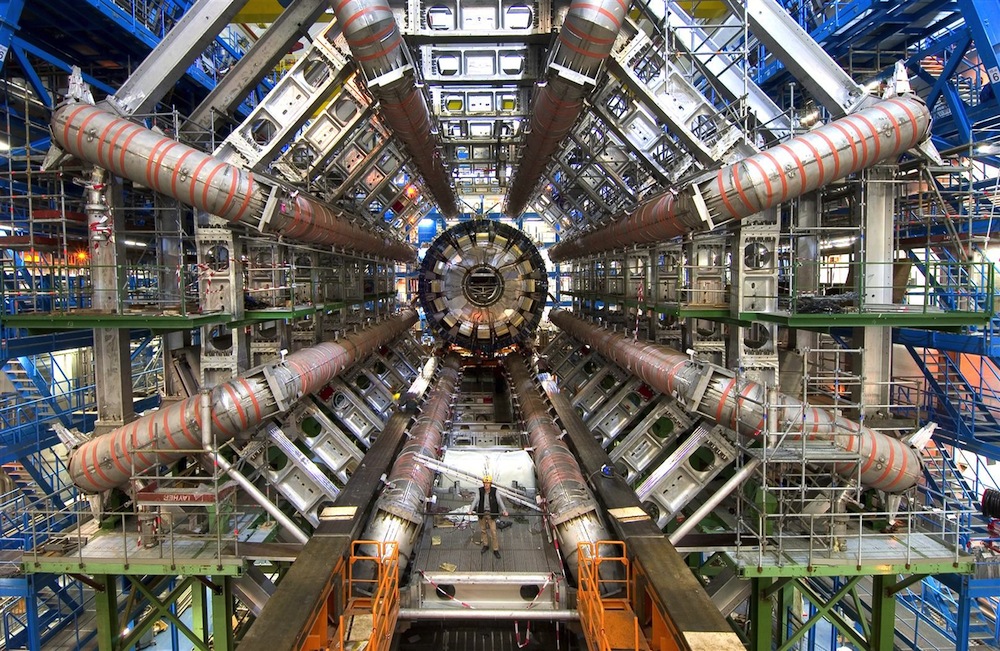Story of the Biggest Experiment in History Caught on Film

On July 4, 2012, scientists around the world waited with bated breath for the announcement that the long-awaited Higgs boson particle had been discovered. The finding — the result of the biggest and most expensive experiment in history — was set to either confirm reigning models of particle physics, or reveal gaps in scientists' understanding of the universe.
A new documentary follows six scientists during the launch of the machine that made the discovery possible, the Large Hadron Collider (LHC), a gigantic particle accelerator at the European Organization for Nuclear Research (CERN), in Switzerland, as they attempt to recreate the earliest moments of the universe. "Particle Fever" captures the scientists' sense of excitement and foreboding leading up to the discovery of the Higgs, the particle that explains how other particles get their mass.
"I knew this big event was coming, and I wanted it recorded," said producer David Kaplan, a physicist at Johns Hopkins University in Baltimore, Md. "I knew it was going to be extremely dramatic scientifically, and also emotionally, for all of my colleagues," Kaplan told Live Science.
The film, which opens March 5 in New York and March 21 in Washington, D.C., stars a group of theoretical and experimental physicists united by a quest to probe the nature of the universe, using the world's most powerful particle accelerator. The LHC collides two beams of protons (particles that make up the nuclei of atoms) at near light-speed around the 17 miles (27 kilometers) of the machine's ring. The collisions produce new particles, which could reveal the composition of space itself. [In Photos: Search for the Higgs Boson]
The film opens during the first test of a single proton beam in September 2008. Viewers meet Fabiola Gianotti, the former spokeswoman for ATLAS, one of the two LHC experiments that detected the Higgs, as well as experimental physicists Monica Dunford and Martin Aleksa, both at ATLAS, who rose to prominence throughout the course of the experiment. Mike Lamont, the LHC's beam operation leader, also features in the film. Lamont faces the formidable challenge of ensuring the LHC's successful launch and operation.
But to understand why scientists need the LHC, one first has to understand the hypotheses it is putting to the test.
Supersymmetry vs. multiverse
Get the world’s most fascinating discoveries delivered straight to your inbox.
The Standard Model of particle physics, finalized in the 1970s, seeks to explain the origin of matter and forces in the universe. The model predicts the existence of a few fundamental particles, including the Higgs boson, theorized by British physicist Peter Higgs in 1964. Finding the Higgs confirms the existence of the Higgs field, and this field gives all other particles their mass.
An extension of the Standard Model known as supersymmetry suggests a highly structured and symmetrical universe, in which every particle has a supersymmetric twin that has yet to be discovered. Another, somewhat radical hypothesis suggests the known universe is part of a much larger, chaotic multiverse, in which the laws of physics are random.
The film pits Kaplan and Stanford theorist Savas Dimopoulos, proponents of supersymmetry, against the young Princeton theorist Nima Arkani-Hamed, a supporter of the multiverse idea. The LHC offers the chance to test these hypotheses for the first time. If supersymmetry proves itself, physicists are on the right track. On the other hand, "We may fall off a cliff," and find that the fundamental laws of physics turn out to be random, Kaplan said.
Biggest experiment in history
The beam test went off successfully in 2008, but a few weeks later, a catastrophic explosion in the facility vented liquid helium, damaging many of the magnets inside the LHC.
"The whole film changed," said director Mark Levinson, who added he didn't know how long it would take to fix the damage, and whether the film would have a happy ending. Fortunately, repairs were completed, and the collider was up and running by November 2009. [See a Clip from the Film 'Particle Fever']
Fast-forward to July 2012, and the discovery of the Higgs. The particle observed by the LHC confirmed what physicists had long suspected, but also brought up new questions.
Most supersymmetry models predict a Higgs boson with a mass of about 115 gigaelectronvolts, or GeV, whereas multiverse models predict a heavier mass of about 140 GeV. The Higgs observed by the LHC was about 125 GeV — smack in the middle, which doesn't confirm or rule out either theory. Instead, it merely narrows down the possibilities.
It's like being lost in the woods, and then getting a hint of the broad direction you should go, Kaplan said, adding, "At least you know which way to start walking."
In the next step, scientists will collide protons at higher energies, to see if even more particles are created, as predicted by supersymmetry. The LHC was shut down for upgrades in 2013, with plans to reopen it running at twice the power in 2015.
The filmmakers hope "Particle Fever" gives audiences an appreciation of particle physics, and gets them excited about learning more. As Kaplan said, "We want people to come out thinking physics is awesome."
Editor's Note: This article was updated at 6:07 p.m. ET, to correct references to untested "theories" to "hypotheses" or "models."
Follow Tanya Lewis on Twitter and Google+. Follow us @livescience, Facebook & Google+. Original article on Live Science.



